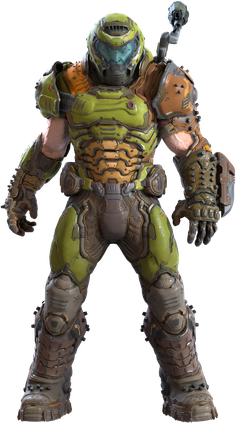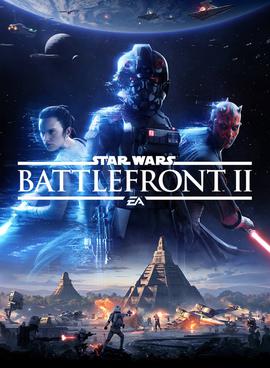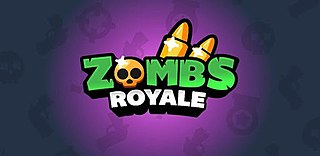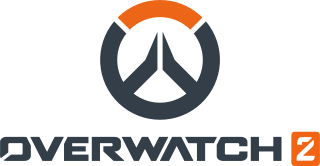Free-to-play video games are games that give players access to a significant portion of their content without paying or do not require paying to continue playing. Free-to-play is distinct from traditional commercial software, which requires a payment before using the game or service. It is also separate from freeware games, which are entirely costless. Free-to-play's model is sometimes derisively referred to as free-to-start due to not being entirely free. Free to play games have also been widely criticized as “pay-to-win”— that is, that players can generally pay to obtain competitive or power advantages over other players.

The Doomguy is a fictional character and the protagonist of the Doom video game franchise of first-person shooters created by id Software. He was created by American video game designer John Romero. He was introduced as the player character in the original 1993 video game Doom. Within the Doom series, Doomguy is a demon hunter space marine dressed in green combat armor who rarely speaks onscreen, and his personality and backstory were intentionally vague to reinforce his role as a player avatar. In Doom Eternal, he is voiced by American voice actor Matthew Waterson, while Jason Kelley voices the character in that game's downloadable content The Ancient Gods: Part Two. He has appeared in several other games developed by id Software, including Quake Champions and Quake III Arena.
Microtransactions, often abbreviated as mtx, are a business model where users can purchase virtual goods with micropayments. Microtransactions are often used in free-to-play games to provide a revenue source for the developers. While microtransactions are a staple of the mobile app market, they are also seen on PC software such as Valve's Steam digital distribution platform, as well as console gaming.

A Mii is a customizable avatar used on several Nintendo video game consoles and mobile apps. The name Mii is a portmanteau of “Wii” and “me”, referring to them typically being avatars of the players. Miis were first introduced on the Wii console in 2006 and later appeared on the 3DS, Wii U, the Switch, and various apps for smart devices. Miis can be created using different body, facial and clothing features, and can then be used as characters within games on the consoles, either as an avatar of a specific player or in some games portrayed as characters with their own personalities. Miis can be shared and transferred between consoles, either manually or automatically with other users over the internet and local wireless communications.
The fighting game series Super Smash Bros. from Nintendo, launched in 1999, features an assortment of video game characters from different franchises. There are 89 playable characters across the series, mostly sourced from Nintendo franchises but with a number of third-party ones as well. There are also other non-player characters that take the form of enemies, bosses, and power-ups.
Unlockable content refers to content that is available in video games but not accessible unless something is performed by the player to get access to it. Different genres of games have different styles and options of unlockable content that is standard among their games. The unlockable content varies, and can be as little as a single weapon or enhancement, to more than doubling the playable characters available to the player.

Counter-Strike: Global Offensive (CS:GO) is a 2012 multiplayer tactical first-person shooter developed by Valve and Hidden Path Entertainment. It is the fourth game in the Counter-Strike series. Developed for over two years, Global Offensive was released for OS X, PlayStation 3, Windows, and Xbox 360 in August 2012, and for Linux in 2014. Valve still regularly updates the game, both with smaller balancing patches and larger content additions.

Fortnite: Save the World is a cooperative hybrid-third-person looter shooter tower defense sandbox survival video game developed and published by Epic Games, part of the game Fortnite. The game was released as a paid-for early access title for Microsoft Windows, macOS, PlayStation 4 and Xbox One on July 25, 2017, with plans for a full free-to-play release announced in late 2018. Epic eventually opted to move the game to pay-to-play in June 2020. The retail versions of the game were published by Gearbox Software, while online distribution of the PC versions is handled by Epic's launcher.

Tomodachi Life is a social simulation video game developed by Nintendo SPD and published by Nintendo for the Nintendo 3DS. The game follows the day-to-day interactions of Mii characters as they build friendships, solve problems, and converse with the player. Tomodachi Life is the sequel to the Japan-exclusive Nintendo DS title Tomodachi Collection.
Video game monetization is a type of process that a video game publisher can use to generate revenue from a video game product. The methods of monetization may vary between games, especially when they come from different genres or platforms, but they all serve the same purpose to return money to the game developers, copyright owners, and other stakeholders. As the monetization methods continue to diversify, they also affect the game design in a way that sometimes leads to criticism.

Paragon was a free-to-play multiplayer online battle arena game developed and published by Epic Games. Powered by their own Unreal Engine 4, the game started buy-to-play early access in March 2016, and free-to-play access to its open beta started in August 2016. Epic Games shut down its servers in April 2018.
In video games, skin gambling is the use of virtual goods, often cosmetic in-game items such as "skins", as virtual currency to bet on the outcome of professional matches or on other games of chance. It is commonly associated with the community surrounding Counter-Strike: Global Offensive, but the practice exists in other games such as Electronic Arts's FIFA. Valve, the developer of Global Offensive, also runs the Steam marketplace which can be interfaced by third-parties to enable trading, buying, and selling of skins from players' Steam inventories for real-world or digital currency. Valve condemns the gambling practices as it violates the platform's Terms of Service.
Overwatch and Overwatch 2 are online team-based first-person shooters developed by Blizzard Entertainment, and released worldwide in May 2016 and October 2022, respectively. Players select from one of over 30 heroes, broadly classified into the three roles of Tank, Damage, and Support, and work with their team to attack or defend map objectives. Each hero has a unique set of weapons, abilities, and skills, which players use to coordinate with their team to overpower the other. Overwatch supports both casual and ranked matchmaking, as well as a rotating set of arcade modes, and the game has since become a popular esport, featuring the Overwatch League that started in 2018. The game has been both a critical and financial success for Blizzard, exceeding over 30 million players and obtaining over US$1 billion in revenue within its first year.

A compulsion loop or core loop is a habitual chain of activities that will be repeated by the user to cause them to continue the activity. Typically, this loop is designed to create a neurochemical reward in the user such as the release of dopamine.

Star Wars Battlefront II is an action shooter video game based on the Star Wars franchise. It is the fourth main installment of the Star Wars: Battlefront series, and a sequel to the 2015 reboot of the series. It was developed by DICE, in collaboration with Criterion Games and Motive Studios, and published by Electronic Arts. The game was released worldwide on November 17, 2017, for the PlayStation 4, Windows, and Xbox One. The game features both single-player and multiplayer modes, and overall includes more content than its predecessor. The single-player campaign of the game is set between the films Return of the Jedi and The Force Awakens, and follows an original character, Iden Versio, the commander of an Imperial special ops strike force dubbed Inferno Squad, who defects to the New Republic after becoming disillusioned with the Galactic Empire's tactics. Most of the story takes place during the final year of the Galactic Civil War, before the Empire's definitive defeat at the Battle of Jakku.

In video games, a loot box is a consumable virtual item which can be redeemed to receive a randomised selection of further virtual items, or loot, ranging from simple customization options for a player's avatar or character to game-changing equipment such as weapons and armor. A loot box is typically a form of monetisation, with players either buying the boxes directly or receiving the boxes during play and later buying "keys" with which to redeem them. These systems may also be known as gacha and integrated into gacha games.

Fortnite Battle Royale is a free-to-play battle royale video game developed and published by Epic Games. It is a companion game to Fortnite: Save the World, a cooperative survival game with construction elements. It was initially released in early access on September 26, 2017, for Windows, macOS, PlayStation 4, and Xbox One, followed by ports for iOS, Android, and Nintendo Switch the following year. Epic dropped the early access label for the game on June 29, 2020. Versions for the PlayStation 5 and Xbox Series X/S were released as launch titles in late 2020.

In the video game industry, a battle pass is a type of monetization approach that provides additional content for a game usually through a tiered system, rewarding the player with in-game items for playing the game and completing specific challenges. Inspired by the season pass ticketing system and originating with Dota 2 in 2013, the battle pass model gained more use as an alternative to subscription fees and loot boxes beginning in the late 2010s. Battle passes tend to offer free passes, which are available to all users, and a premium pass that require annual or seasonal charges in exchange for enhanced items and cosmetics.

ZombsRoyale.io is a 2D battle royale video game developed by an American studio, End Game. It was released on 2018 for iOS, Android and on web browsers. Similar to other titles in the battle royale genre, players fight against other players on a large map from a top-down perspective, scavenging for supplies and weapons.

Overwatch 2 is a 2022 first-person shooter game by Blizzard Entertainment. As a sequel and replacement to the 2016 hero shooter Overwatch, the game intends a shared environment for player-versus-player (PvP) modes while introducing persistent cooperative modes. A major change in PvP modes was to reduce team sizes from six to five. Several major characters were also reworked. Overwatch 2 is free-to-play on Nintendo Switch, PlayStation 4, PlayStation 5, Windows, Xbox One, and Xbox Series X/S in early access on October 4 and features full cross-platform play.













